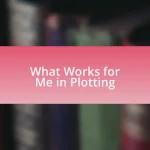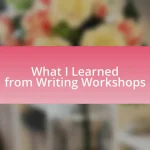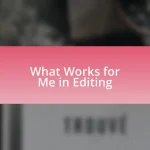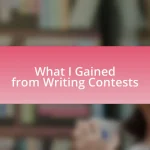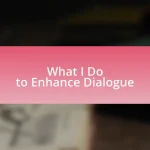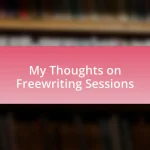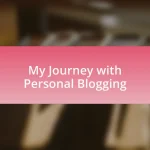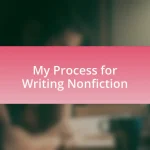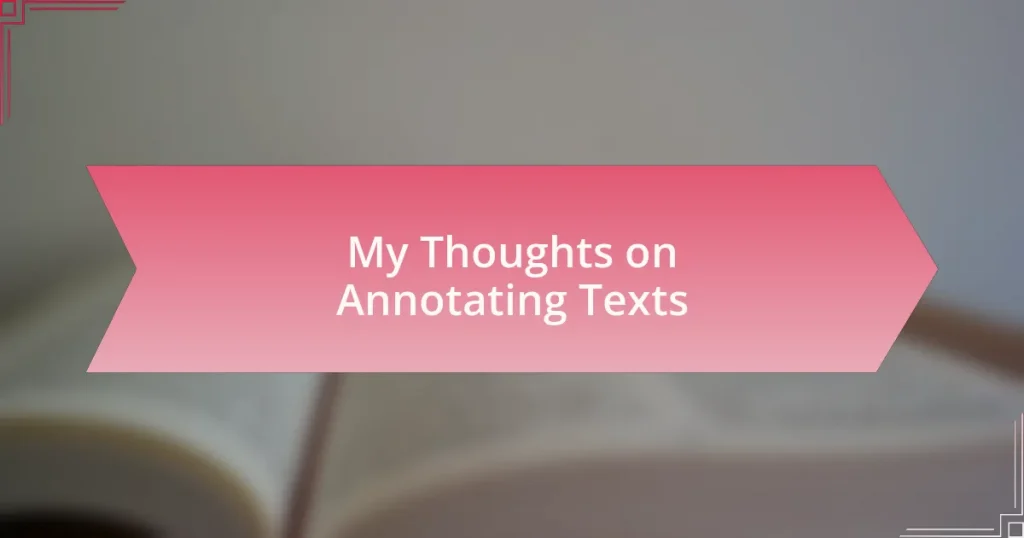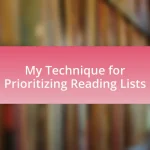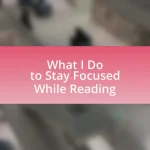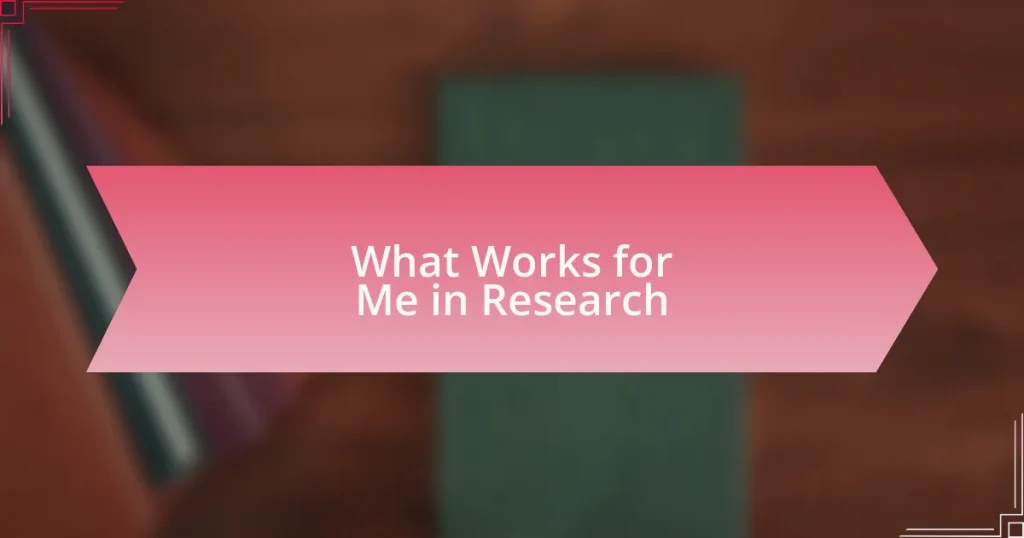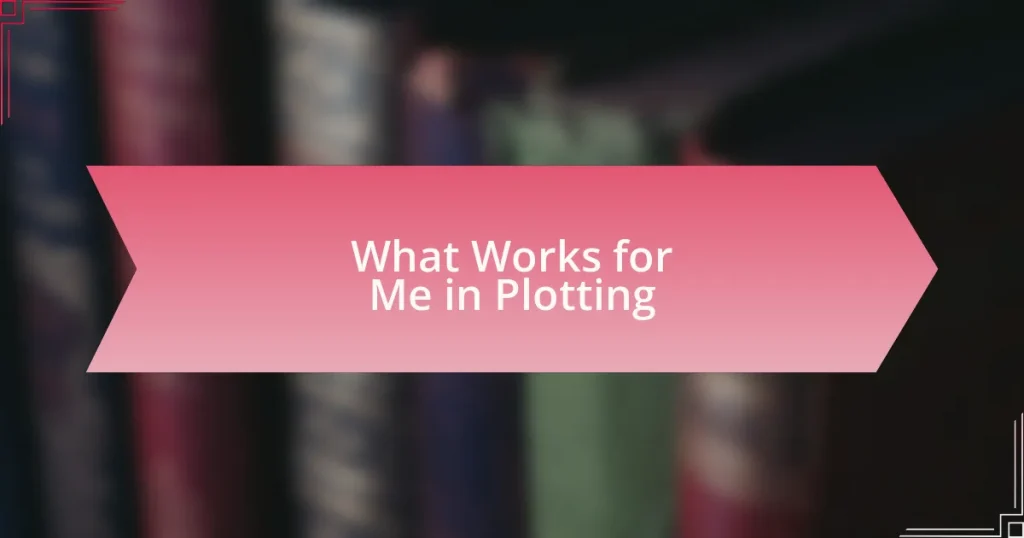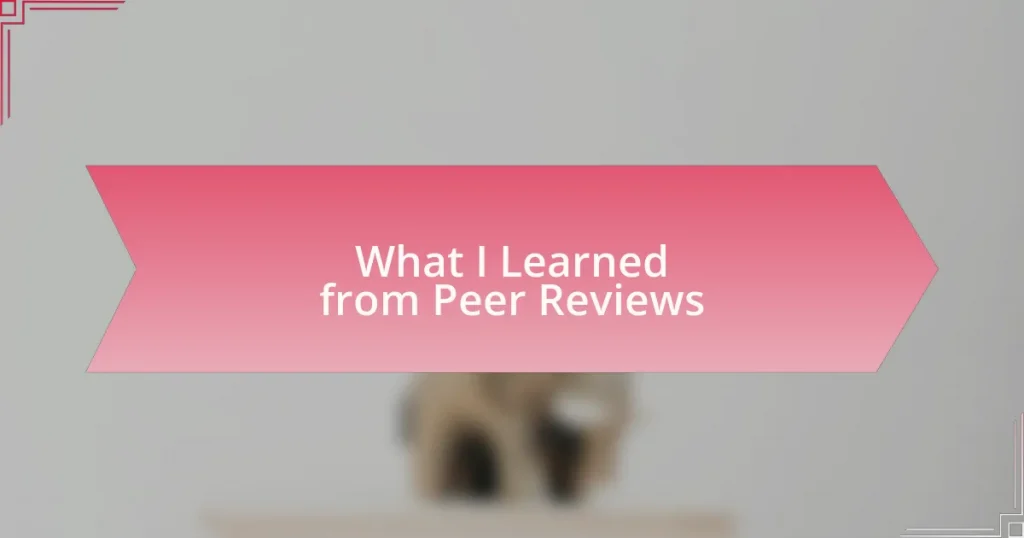Key takeaways:
- Text annotation transforms passive reading into an active dialogue, enhancing engagement and understanding.
- Effective techniques for annotating include using symbols, summarizing sections, and asking questions to create a personal connection with the text.
- Utilizing digital and physical tools for annotation can enrich the reading experience and aid in retention and organization of thoughts.
- Annotating fosters critical thinking and creates a personalized dialogue with the material, turning reading into a transformative experience.
Author: Clara Whitfield
Bio: Clara Whitfield is a captivating storyteller and acclaimed author known for her rich, character-driven narratives that explore the complexities of human relationships. With a background in psychology and a passion for literature, Clara weaves intricate plots that resonate with readers on multiple levels. Her debut novel, “Echoes of the Heart,” received critical acclaim and was a finalist for several literary awards. When she’s not writing, Clara enjoys hiking in nature, experimenting in the kitchen, and engaging with her vibrant community of fellow writers. She resides in Portland, Oregon, where she draws inspiration from the lush surroundings and eclectic culture.
Understanding text annotation
Text annotation is more than just marking up a document; it’s a way to engage deeply with the material. I remember the first time I annotated a novel for a literature class. I scribbled my thoughts in the margins, and suddenly, the story came to life. Each note I made became a little conversation I was having with the author, revealing insights I might have otherwise missed.
In my experience, effective annotation transforms the reading process. As I flip through my books, I often find little gems of understanding captured in my handwriting. It makes me wonder, how many moments of clarity have you missed in your own readings by simply skating over the text? Annotation invites you to pause and reflect, turning passive reading into an active dialogue.
When you annotate, you are not just noting thoughts or questions; you are creating a roadmap of your journey through the text. I’ve often found that days or weeks later, revisiting those annotations enables me to reconnect instantly with my previous emotions and insights. How powerful is that connection? It’s a reminder that every reader’s interaction with a text is unique and worthy of exploration.
Importance of annotating texts
Annotating texts holds immense importance because it allows us to personalize our engagement with the material. I recall a time when I annotated a complex research article for a project. My notes not only helped clarify the author’s arguments but also sparked new questions about the implications of the study. How often do we take the time to note our thoughts when confronted with dense information? By annotating, I transformed that overwhelming text into a conversation that made the content more accessible and meaningful.
Moreover, annotating serves as a memory aid that enhances retention. I remember attending a workshop where the facilitator emphasized the impact of handwritten notes on recall. After applying this technique during my reading sessions, I found that revisiting my annotations often summoned vivid recollections of insights and emotions related to the text. Doesn’t it feel rewarding to have a tangible representation of your learning journey? This practice fosters a deeper connection with the material that mere reading alone can’t achieve.
Additionally, annotations create a valuable resource for future reference. I’ve developed a habit of flipping back through my annotated texts before discussions or papers. Each margin note acts like a breadcrumb trail leading me back to the core ideas and my responses at the time. Isn’t it incredible how those little reminders can reignite thoughts and feelings from prior reads? This process not only enriches my understanding but also encourages continuous engagement with the material long after the initial reading.
Techniques for effective annotation
When it comes to effective annotation, I’ve discovered that using symbols can significantly enhance my understanding of the material. For instance, I often use a star to mark important points or a question mark for concepts I’m unsure about. Have you ever looked back at your notes and realized how those simple symbols can act as a quick visual guide? They help streamline my review process, making it easier to locate key ideas without having to reread everything.
Another technique that has worked wonders for me is summarizing sections in my own words. After finishing a paragraph, I take a moment to jot down a brief summary that captures the essence of what I just read. I remember when I did this for a challenging novel; distilling complex themes into simple phrases not only clarified my understanding but made the experience feel more intimate. Don’t you find that when you put things in your own language, they resonate more deeply?
Lastly, engaging in a dialogue with the text by asking questions has proven invaluable. As I annotate, I often write my reactions beside the text, reflecting on how I personally relate to the ideas presented. Once, while annotating a poignant essay on identity, I found myself questioning my own views, leading to a deeper explorative journey. It’s true—by interacting with the text in this way, I’m not just absorbing information; I’m creating a meaningful conversation between my experiences and the author’s words. Isn’t it fascinating how this approach transforms reading into a more dynamic and personal endeavor?
Tools for annotating texts
When it comes to tools for annotating texts, I’ve found digital platforms like Evernote and OneNote to be incredibly helpful. These applications allow me to highlight passages, add sticky notes, and even attach voice memos for a more rounded understanding. Have you ever tried using different colors for different types of comments? It adds another layer of organization that makes my annotations visually engaging and easy to navigate.
Beyond software, I often turn to physical tools like highlighters and sticky notes. I remember vividly annotating a dense academic article while using neon highlighters to mark pivotal arguments and shades of green and yellow to differentiate my thoughts from the author’s voice. The result? A rainbow of insights that not only brightened the text but transformed it into a personal treasure map of ideas. Isn’t it satisfying to watch your annotations evolve into a vivid narrative of the text itself?
Additionally, I can’t emphasize enough the value of annotation apps specifically designed for reading, like Notion or LiquidText. These tools allow for a fluid interaction with the text, enabling connections and branching thoughts that paper could never accommodate. I once spent hours dissecting a complex theory using LiquidText and found that the mind-mapping features helped me visualize concepts in a way that felt oddly liberating. Have you experienced that moment when everything clicks, and your annotations feel like a living document? It’s like discovering a dialogue where you are both the reader and the author.
My personal approach to annotation
My personal approach to annotation blends intuition with strategy. When I dive into a text, I often start by reading through it once without making any marks. This initial read is a bit like tasting a dish before deciding what seasoning it needs. I find that this helps me grasp the main ideas and emotions conveyed by the author before I flood the page with my thoughts. Have you ever noticed how a first impression can shape your deeper understanding?
Once I have my baseline, I begin annotating with purpose. I remember tackling a challenging literary piece where I used the margin to jot down my reactions and connections. It felt like having a conversation with the author, and I made sure my comments reflected my personal journey through the text. Each note became a stepping stone, guiding me deeper into the narrative. Do you ever feel that your annotations become a dialogue, revealing new insights as you reread your notes?
Color plays a pivotal role in my annotation method. While working on a particularly intense essay, I decided to assign specific colors to themes, questions, and personal reflections. Watching my page transform into a vibrant tapestry of ideas was nothing short of exhilarating. There’s something uniquely satisfying about visual clarity that reinforces my understanding. Have you explored how colors can transform your thoughts into a cohesive visual story?
Benefits I gain from annotating
Annotating has brought several tangible benefits to my reading and comprehension process. One time, while working through a dense philosophical text, my annotations helped me break down complex arguments into manageable parts. By summarizing key points in my own words, I found clarity that made the ideas resonate more deeply. Have you tried that approach when tackling challenging material?
Another advantage I’ve experienced is the enhancement of my critical thinking skills. I remember reading a novel where I not only highlighted key passages but also wrote questions in the margins. This practice forced me to engage actively with the text rather than passively absorb information. I often reflect on how these questions lead me to discover deeper meanings, fostering a sense of curiosity and exploration. Don’t you think that asking questions can unlock new interpretations?
Perhaps the most rewarding benefit has been the creation of a personalized dialogue with the text. As I annotate, I often share my thoughts and feelings, which makes the reading experience incredibly intimate and rewarding. I once annotated a memoir, and my notes became a safe space for my reflections and emotions. Do you find that when you engage in this personal dialogue, it turns your reading into a transformative experience?

